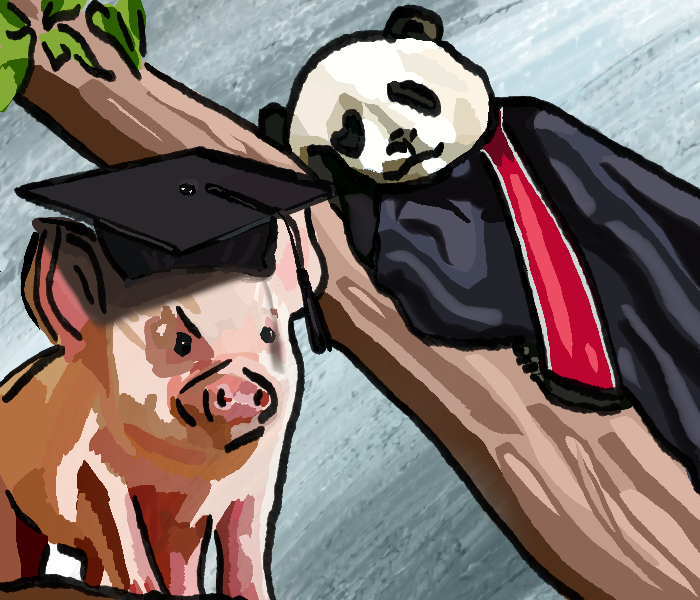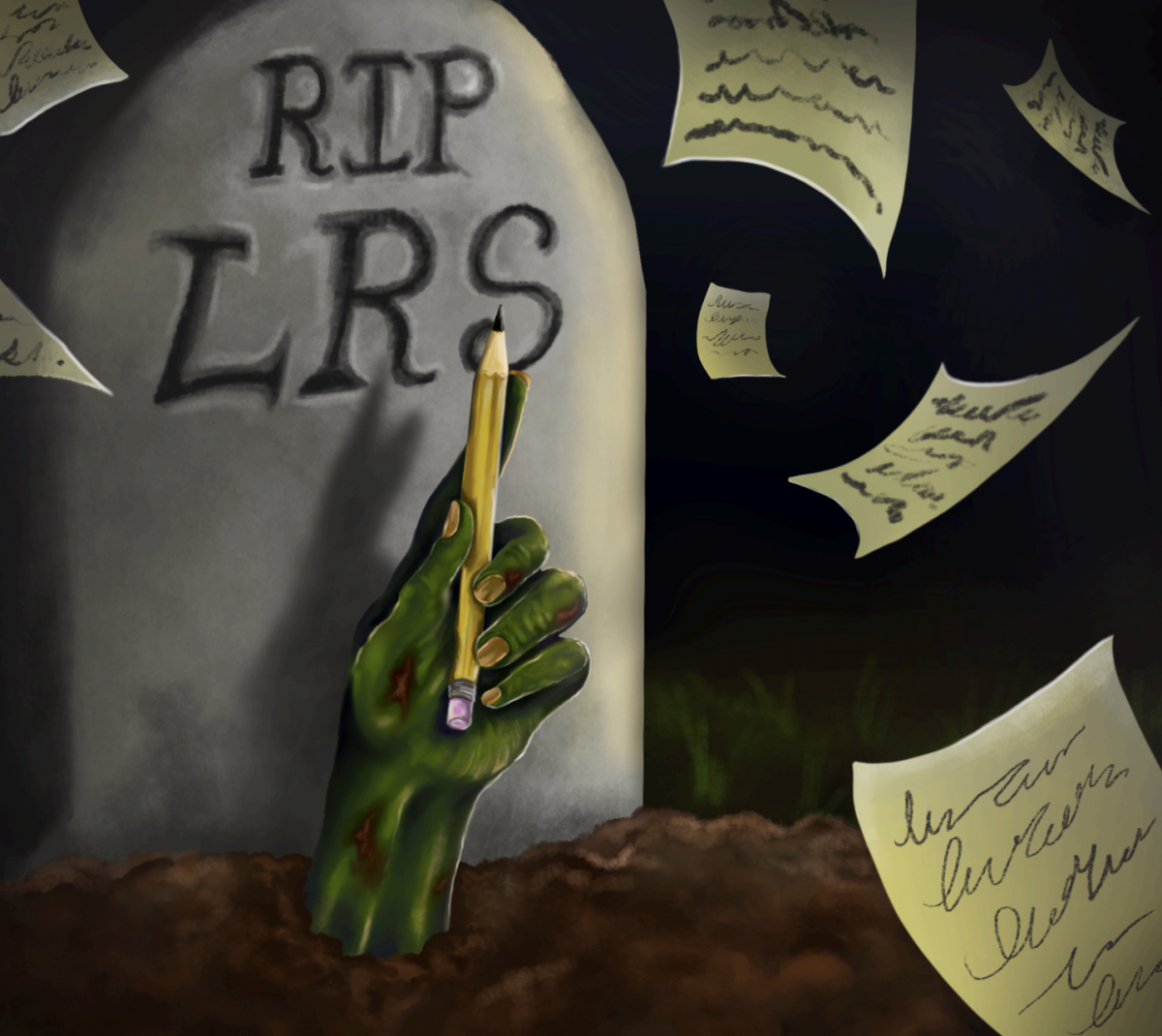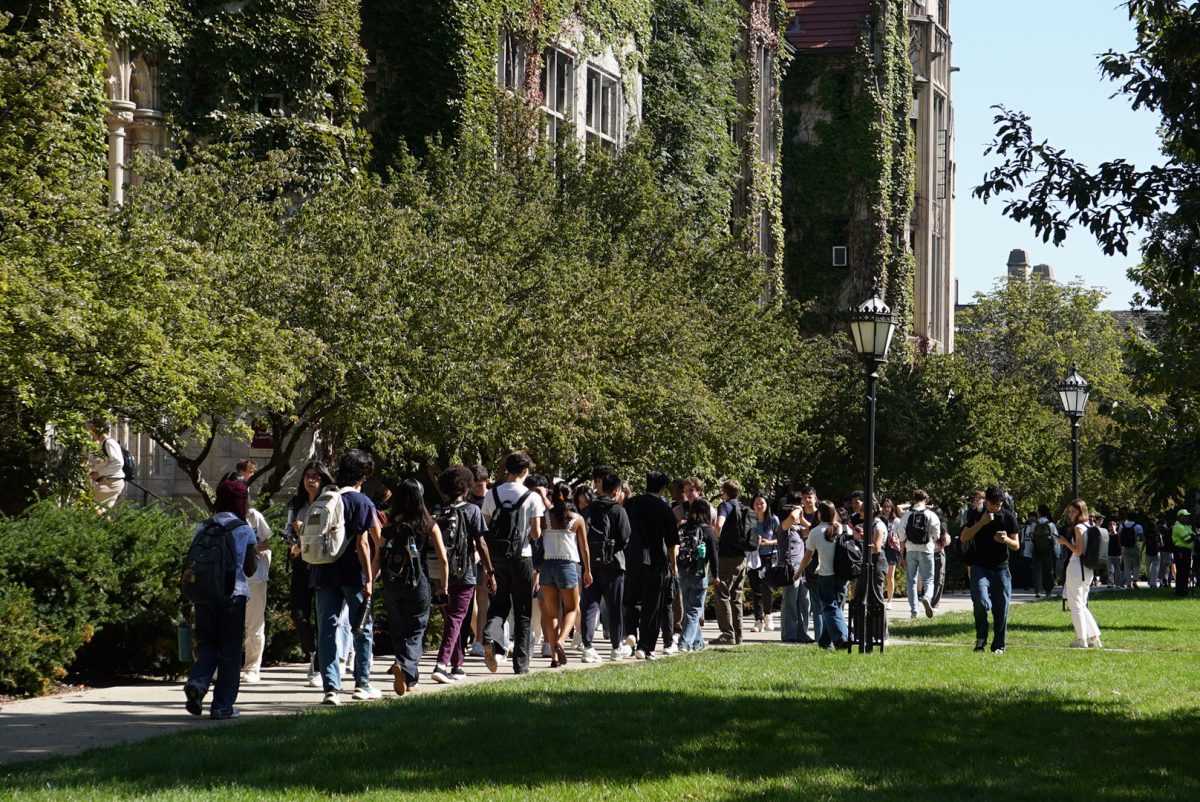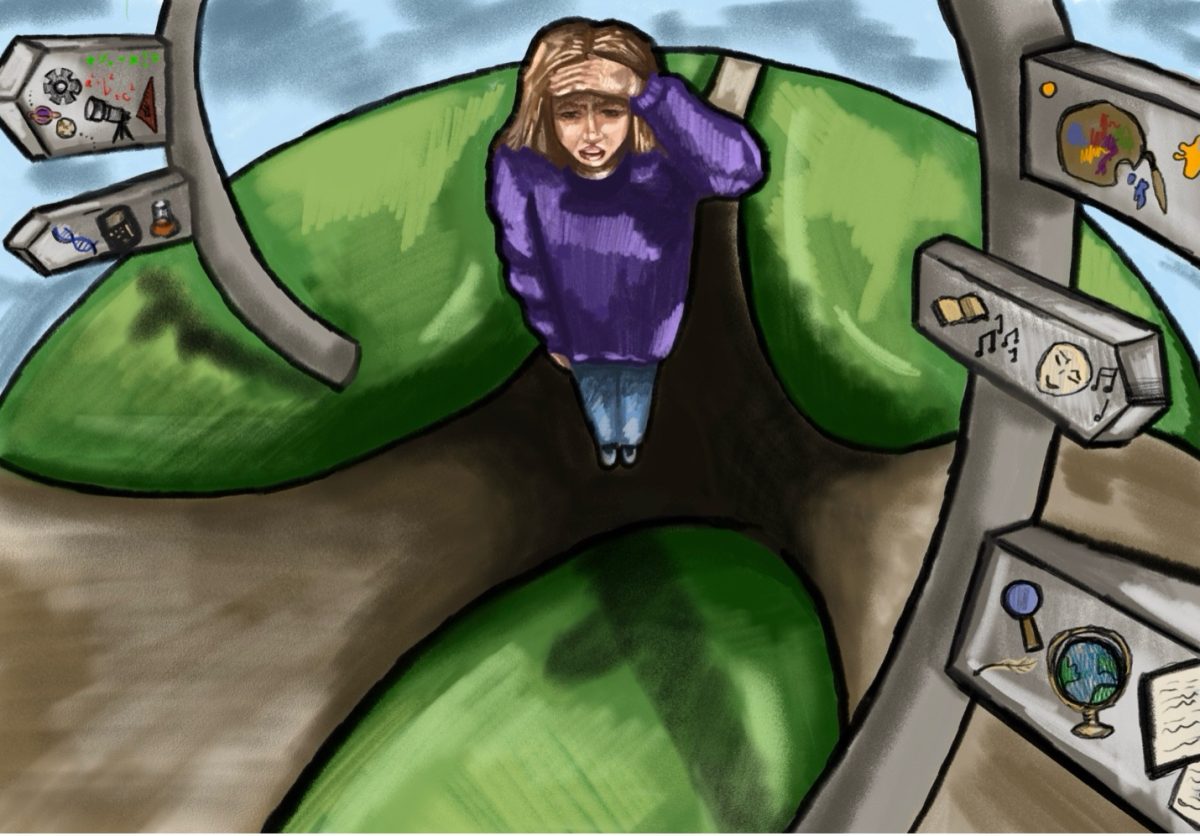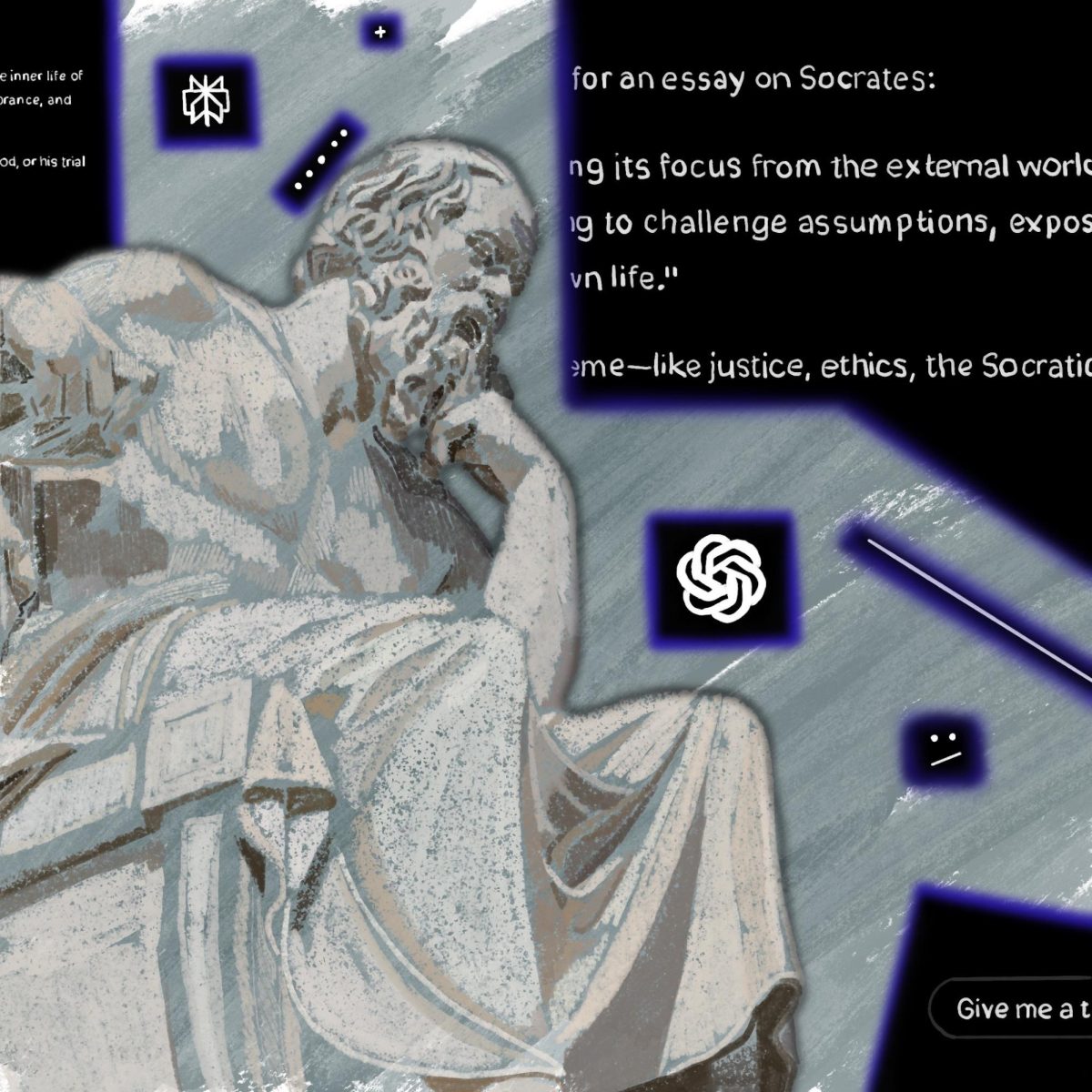I had a nightmare: I walked into a special exhibition at the Field Museum titled “The Most Wonderful Extinct Species.” There were giant dinosaur skeletons, a model of a running dodo, and a Bramble Cay melomys that was seemingly still feasting on a glowing coral reef. At the end of the exhibit stood a large, several-meter-tall copper statue resembling the Michael Jordan sculpture at the United Center.
The difference was that this statue was dressed in a slightly over-the-top academic cap and gown read: “This is the last Ph.D. graduate in the humanities from the University of Chicago. Name and dates of birth and death unknown. The museum would be grateful for any information regarding his/her life.”
I sincerely hope this is nothing but a nightmare. This summer quarter—a time of year when most students and faculty are gone, or at least not at full capacity, the University of Chicago announced a series of major policy changes, starting with a reorganization plan for the Division of the Arts & Humanities and the pausing of admissions for many Ph.D. programs in the humanities, social sciences, and Harris and Crown Schools. Only a few days ago, President Alivisatos and Provost Baicker made a few announcements to the faculty and staff of the University on their budget cut plans. These communications included a letter addressed to the faculty, a letter to the University staff, a letter from the Provost, and an FAQ page. After these announcements were made, the Dean of the Division of the Social Sciences (SSD), also sent an email to faculty, staff, and Ph.D. students in the SSD regarding these University-wide changes, and also offered some details on how the SSD in particular planned to implement these changes.
The recent announcements from the University have helped us, as members of the University community, better understand the specific measures of the school’s upcoming fiscal budget reduction plan. This is a commendable move. However, for most doctoral students, MA students, and undergraduates, the direct communications from the University remain few. This past month, I only received two emails about these major policy changes, which is even fewer than the number of messages about the SSD building being flooded.
Many of my colleagues are surprised, anxious, and uneasy about these sudden changes. Others are simply bewildered, as they know little about the current financial crisis or the University’s developmental trajectory up to this point. This is why I feel compelled to write this op-ed. In this existential crisis for the humanities and social sciences at UChicago, and more broadly, in U.S. higher education, how should we view and understand these changes?
I do not intend to wade into normative arguments about American higher education these days: an alert reader can easily find endless discussions about what a university is, what it should do, and many ideas about how to save them, since the Trump administration began its crackdown on academia. As a history student, I’m more interested in making an interpretation of the underlying patterns of these events, and, in particular, placing the recent policy changes at UChicago within a historical context. Curiously, when I hear these discussions about the future of the humanities and social sciences in American universities, I’m always reminded of an article I read years ago by John McNeill (a UChicago Lab School alum), titled “Homogeneity, Heterogeneity, Pigs and Pandas in Human History.”
In this paper, professor McNeill proposes two different models for understanding nations, societies, and civilizations throughout history. The first, which he calls the “pig model,” is named for species like pigs, rats, and cockroaches, which are famous for their versatility and ability to adapt to environmental changes. The other he calls the “panda model,” for animals like pandas, koalas, and sharks, which have become so highly specialized to a particular environment that they become extremely vulnerable to extinction once that environment changes, as the panda did in southwestern China in the 19th and 20th centuries.
This pig-panda distinction might seem superficial and unproductive. Since human affairs are in constant flux, wouldn’t all pig-like societies be more successful in the long run? They would seem to be the inevitable victors of the Darwinian law of survival of the fittest. Could panda-like societies avoid the inevitable fate of being naturally selected out? Unless saved by humanity’s all-knowing and all-powerful hand, at great cost, they would face the same end as the panda.
McNeill’s answer in the article is a resounding “no.” He points out that for most of human history, “social formats” (a term he popularized in this article and his book Human Web: A Bird’s-Eye View of World History) with “panda-like” characteristics, not limited to any specific nation or civilization, appear to have been more successful. From the emergence of homo sapiens around 300,000 years ago, to roughly 5000 BC, “the band of 30–80 kin” seems to have been a globally successful panda model. Smaller groups tended to merge or go extinct, while larger ones tended to fragment.
This pattern only gradually changed with the global expansion of the agricultural revolution—but agriculture didn’t bring about a new pig model, but rather a new panda-like society (which he inclines to calls a “koala” society): the stable nation-state. This social model, which originated in Mesopotamia 5,500 years ago, spread across Afro-Eurasia. Despite countless upheavals, wars, revolutions, famines, and epidemics, it continued as the standard form of social organization from antiquity until the late 19th and early 20th centuries. It wasn’t until the successive collapses of the Mughal Empire, the Qing Empire, the Romanov dynasty, and the Ottoman Empire that this agrarian state—with an elite of intellectuals and military experts and a foundation of peasant farmers—ceased to be the social format in which the majority of the world’s population lived.
Of course, this “panda-like” social format was not universally more successful in all historical periods or at all levels of analysis. A notable exception is contemporary capitalist society—the cry of “the end of history” and the announced global victory of democracy over dictatorship in the 1990s seems a bit premature now. While the public may continually hope for a relatively stable social model, from a global perspective, the continuous and drastic changes of the 20th century have yet to produce a single highly specialized victor in terms of ideal social format.
If modern history is too short, a more convincing example of the comparative advantages of a “pig-like” social format might be found in the longue durée history of religion. As McNeill notes, religious sects that possess “a certain vagueness (extending to self-contradiction) allowing a vast range of interpretations” seem to have had more vitality over the long term than those that were “too morally stringent and consistent (Shakers, perhaps).” In other words, more pig-like, flexible, and adaptable religions appear to have more followers and longer lives, while religions or folk beliefs that worship specific beings or have specific purposes tend to lose most of their followers and become extinct when their social environment changes.
If you’ve read this far, I trust that you have found the connection between pigs, pandas, and the changes currently taking place in American higher education. Setting aside the a priori value judgments of what a university is, we can roughly divide those currently pushing for university reform into two camps. One believes that the modern university must have sufficient pig-like characteristics, meaning it must continuously, flexibly, and almost unrestrictedly change to gain a competitive advantage against environmental pressures like finance, politics, and the market. The other group believes that a university should be more like a panda: it can also embrace change, but its changes are more like a path-dependent specialization. In a relatively stable social environment, the strengths brought by this specialization are a survival advantage.
Looking at the history of modern universities, the proponents of panda-like university have gained the upper hand. We can provisionally call most of today’s elite American universities the successors to the “Berlin/Humboldt” model. Famous examples include the founding president of Johns Hopkins University, Daniel Coit Gilman; the series of reforms led by Charles Eliot at Harvard in the latter half of the 19th century; and, of course, the idealism, faith, and practical spirit of my alma mater, the University of Chicago, under the leadership of a young William Rainey Harper. If there had been a global university ranking from the early 20th century, one can almost say with certainty that for the entire century, with the exception of Cambridge and Oxford, most of the top-ranked universities—whether in North America, Europe, or Japan—adhered to some basic, panda-like characteristics of the modern university as designed by Wilhelm von Humboldt in 1810. These include academic freedom, the integration of research and teaching, an emphasis on both the acquisition of natural science and the cultivation of humanistic spirit, relative administrative independence despite receiving state funding, and, last but not least, the establishment of a research-focused Ph.D. training system. In other words, they not only teach students but also train future scholars. When I was applying to the history Ph.D. program at UChicago, I still remember the slogan on the website’s self-introduction: at University of Chicago, we are the “teachers of teachers.”
While in many of the current debates, a fair number of commentators (professor Clifford Ando, for example)—especially those from the pinnacle of the ivory tower, or who fancy themselves standing among Raphael’s School of Athens—consider these panda-like characteristics to be the fundamental cornerstones of a university, this doesn’t mean the panda-like format is a perfect, ultimate solution.
As McNeill points out in his article, given a relatively stable environment, a pig-like society or institution can quietly transform into a panda-like one; while in a major crisis, the chance of a panda-like society rebuilding itself as a pig-like one is small, but not impossible—especially if we consider how American higher education has changed since the Reagan era. It has moved from its former role—as a think tank for national strategy and a hub for developing world-changing technologies—to become a modern King Midas, driven by neoliberalism to commercialize its work, patenting research and housing start-ups to turn everything into profit. Many pig-like characteristics adapted to this era have become increasingly apparent in American universities. Big libraries, odd machines in laboratories, eccentric scholars, and the hazy aura of “academic reputation” have all been pushed aside. Today, it is professional schools boasting the salary statistics of their graduates that serve as a university’s true credentials.
From this almost crude Darwinian perspective, every American university, under assault from an aggressive administration, shrinking budgets, disgruntled student bodies, and faculty members who never stop complaining about teaching and research loads, needs to make a choice. They must choose between embracing a panda-like identity or making pig-like changes. To be sure, reducing these complex political, cultural, and internal factors to mere pressures of natural selection is a simplification, but the results are similar: some departments, programs, research, and people will survive, while others will go extinct.
Although I have my own aesthetic preferences and judgments on whether American universities, and UChicago in particular, should be pig-like or panda-like, I am only a Ph.D. student. Unlike the faculty, I have not been granted the prerogative to decide the future fate of this institution. Seeing these messages from the SSD at the height of summer has left me feeling the chill of a Chicago January wind; yet of course I am still grateful that the school has not canceled the stipends and tuition grants for current Ph.D. students.
In discussing this comparison of pigs and pandas, I also have no intention of stirring up a sense of antagonism, of suggesting that the departments and divisions currently being ordered to adjust—such as the Division of the Arts & Humanities, the Harris School of Public Policy, the Crown Family School, and my own SSD—are some sort of infinitely cute and defenseless species, while departments like the business school, molecular biology, and some other departments whose names have the prefix of a fund manager are the successfully evolved Napoleon-esque pigs from Orwell’s Animal Farm. This is neither the intention of this op-ed nor is it factual.
In fact, the financial reality is more complex than a simple “winner-takes-all” narrative. As professor Clifford Ando pointed out in a recent op-ed published in the Maroon, “Contrary to much vernacular opinion, faculty in humanistic fields and the interpretive social sciences are the only faculty in the arts and sciences who systematically pay for themselves.” This highlights that the departments often perceived as “less profitable” are, in fact, financially self-sufficient. We are all in it.
This analogy of pigs and pandas offers only a systematic, value-neutral, and easily understandable perspective. From this perspective, I hope that those who steadfastly support the panda-like university norms can reexamine the foundation of their values and consider the potential costs of this model, as well as the viable survival strategies in a time of crisis. For those who would rather see American higher education, or UChicago, become more pig-like, I hope they will not portray the so-called externalities as a self-evident, unquestionable justification for change. By and large, as Marx put it, we generated our own gravediggers. Finally, this analogy may also serve as an antidote: that the rhetoric attempting to spin these major policy changes into a necessary and temporary sacrifice is not only deceptive but also despicable.
Every era has its own successes and failures, and historians will continue to provide new interpretations of the past. From today’s perspective, the 1960s were indeed a golden age for American higher education—universities expanded, women and ethnic minorities began to enjoy the right to higher education, social movements surged on campuses, ideological clashes were constant but not always violent or counter-productive, and government funding continuously increased.
But Edward Albee’s Who’s Afraid of Virginia Woolf?, written in 1962, offers a completely different picture. The middle-aged historian George and his dissatisfied wife Martha, who is the daughter of the president of the liberal arts college where George teaches, along with the new biology professor Nick and his wife Honey, engage in a chaotic and unpredictable conversation about life, scholarship, and existence. In it, the president’s daughter Martha complains, “What can a historian do? Just sit there and talk.” This echoes the ancient Chinese saying, “A scholar is of no use whatsoever” (百无一用是书生).
As a useless history scholar then, I would like to offer a practical suggestion that can both alleviate UChicago’s current financial strain and significantly increase the transparency of the ongoing fiscal reforms: in addition to dismantling academic departments and their Ph.D. programs, we should, like the International Union for Conservation of Nature Red List, establish a biodiversity extinction risk classification system for all departments and Ph.D. programs on campus, from LC (least concern) to a black and red EX (extinct)—or perhaps EL for “Eliminated” would be more fitting? And we should sell T-shirts printed with these classifications at the University bookstore, which, by the way, no longer sells many books. According to current school policy, the history department might be classified as CR (critically endangered), while anthropology and East Asian studies next door are already EW (extinct in the wild). I believe most of my colleagues would proudly wear these insignias on their chests.
Zhao Fang is a Ph.D. Candidate in the Department of History at the University.



